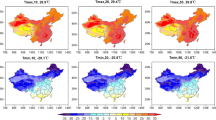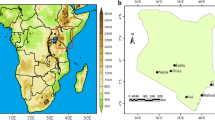Abstract
Two approaches of statistical downscaling were applied to indices of temperature extremes based on percentiles of daily maximum and minimum temperature observations at Beijing station in summer during 1960–2008. One was to downscale daily maximum and minimum temperatures by using EOF analysis and stepwise linear regression at first, then to calculate the indices of extremes; the other was to directly downscale the percentile-based indices by using seasonal large-scale temperature and geo-potential height records. The cross-validation results showed that the latter approach has a better performance than the former. Then, the latter approach was applied to 48 meteorological stations in northern China. The cross-validation results for all 48 stations showed close correlation between the percentile-based indices and the seasonal large-scale variables. Finally, future scenarios of indices of temperature extremes in northern China were projected by applying the statistical downscaling to Hadley Centre Coupled Model Version 3 (HadCM3) simulations under the Representative Concentration Pathways 4.5 (RCP 4.5) scenario of the Fifth Coupled Model Inter-comparison Project (CMIP5). The results showed that the 90th percentile of daily maximum temperatures will increase by about 1.5°C, and the 10th of daily minimum temperatures will increase by about 2°C during the period 2011–35 relative to 1980–99.
Similar content being viewed by others
References
Achberger, C., M.-L. Linderson, and D. Chen, 2003: Performance of the Rossby centre regional atmospheric model in southern Sweden: Comparison of simulated and observed. Theor. Appl. Climatol., 76, 219–234.
Benestad, R. E., 2001: A comparison between two empirical downscaling strategies. Int. J. Climatol., 21, 1645–1668.
Benestad, R. E., 2009: Downscaling precipitation extremes: Correction of analogy model through PDF predictions. Theor. Appl. Climatol., 100, 1–21.
Benestad, R. E., I. Hanssen-Bauer, and D. Chen, 2008: Empirical-Statistical Downscaling. World Scientific Publishing Co. Pte. Ltd., Singapore, 228pp.
Bretherton, C. S., C. Smith, and J. M. Wallace, 1992: An intercomparison of methods for finding coupled patterns in climate data. J. Climate, 5, 541–560.
Chambers, J. M., and T. J. Hastie, 1992: Statistical Models in S. Wadsworth and Brook/cole, Pacific grove, California, 608pp.
Chen, D., C. Achberger, J. Raisanen, and C. Hellstrom, 2006: Using statistical downscaling to quantify the GCM-related uncertainty in regional climate change scenarios: A case study of Swedish precipitation. Adv. Atmos. Sci., 23(1), 54–60.
Chen, D., C. Achberger, U. Postgåard, A. Walther, Y. Liao, and T. Ou, 2008: Using a weather generator to create future daily precipitation scenarios for Swed. Res. Rep. C76, Earth Sciences Centre, University of Gothenburg, Gothenburg, Sweden, 82pp.
Coulibaly, P., 2004: Downscaling daily extreme temperature with genetic programming. Geophys. Res. Lett., 31, L16203, doi: 10.1029/2004GL020075.
Fan, L., 2009: Statistical downscaled temperature scenarios over China. Atmos. Oceanic Sci. Lett., 2(4), 408–213.
Fan, L., 2010: Preliminary study of statistically downscaled temperature ensemble predictions in eastern China. Plateau Meteorology, 29(2), 392–402. (in Chinese)
Fan, L., C. Fu, and D. Chen, 2005: Review on creating future climate change scenarios by statistical downscaling techniques. Advances in Earth Science., 20(3), 320–329. (in Chinese)
Fan, L., C. Fu, and D. Chen, 2007: Estimation of local temperature change scenarios in North China using statistical downscaling method. Chinese J. Atmos. Sci., 31(5), 887–897. (in Chinese)
Fan, L. J, C. B. Fu, and D. L. Chen, 2011: Long-term trend of temperature derived by statistical downscaling based on EOF analysis. Acta Meteorologica Sinica, 25(3), 327–339, doi: 10.1007/s13351-011-0308-0.
Fu, C., Z. Jiang, Z. Guan, J. He, and Z. Xu, 2008: Regional Climate Studies of China. Springer, 476pp.
Gordon, C., C. Cooper, C. A. Senior, H. Banks, J. M. Gregory, T. C. Johns, J. F. B. Mitchell, and R.A. Wood, 2000: The simulation of SST, sea ice extents and ocean heat transports in a version of the Hadley Centre coupled model without flux adjustments. Climate Dyn., 16, 147–168, doi: 10.1007/s003820050010.
Griffiths, G. M., and Coauthors, 2005: Change in mean temperature as a predictor of extreme temperature change in the Asia-Pacific region. Int. J. Climatol., 25, 1301–1330.
Hanssen-Bauer, I., E. J. Forland, J. E. Haugen, and O. E. Tveito, 2003: Temperature and precipitation scenarios for Norway: Comparison of results from dynamical and statistical downscaling. Climate Research, 25, 15–23.
Hanssen-Bauer, I., C. Achberger, R. E. Benestad, D. Chen, and E. Forland, 2005: Statistical downscaling of climate scenarios over Scandinavia: A review. Climate Research, 29, 255–268.
Hass, R., and K. Born, 2011: Probabilistic downscaling of precipitation data in a subtropical mountain area: A two-step approach. Nonlinear Processes in Geophysis., 18, 223–234.
Hellström, C., and D. Chen, 2003: Statistical downscaling based on dynamical downscaled predictors: application to monthly precipitation in Sweden. Adv. Atmos. Sci., 20(6), 951–958.
Hellström, C., D. Chen, C. Achberger, and J. Räissänen, 2001: A comparison of climate change scenarios for Sweden based on statistical and dynamical downscaling of monthly precipitation. Climate Research, 19, 45–55.
Hundecha, Y., and A. Bardossy, 2008: Statistical downscaling of extremes of daily precipitation and temperature and construction of their future scenarios. Int. J. Climatol., 28, 589–610.
Huth, R., 2002: Statistical downscaling of daily temperature in central Europe. J. Climate, 15, 1731–1743.
IPCC, 2007: Climate Change 2007: The Physical Science Basis. Contribution of the Working Group I to the Fourth Assessment Report of the Intergovernmental Panel on Climate Change, S. Solomon et al., Eds., Cambridge University Press, Cambridge, United Kingdom and New York, NY, USA, 996pp.
Jones, P. D., E. B. Horton, C. K. Folland, M. Hulme, D. E. Parker, and T. A. Basnett, 1999: The use of indices to identify changes in climatic extremes. Climatic Change, 42, 131–149.
Kalnay, E., and Coauthors, 1996: The NCEP-NCAR 40-year reanalysis project. Bull. Amer. Meteor. Soc., 77(3), 437–471.
Katz, R. W., and B. G. Brown, 1992: Extreme events in a changing climate: Variability is more important than averages. Climatic Change, 21(3), 289–302.
Lee, T. C., K. Chan, and W. Ginn, 2011a: Projection of extreme temperature in Hongkong in the 21st Century. Acta Meteorologica Sinica, 25(1), 1–20, doi: 10.1007/s13351-011-0001-3.
Lee, T. C., H. S. Chan, E. W. L. Ginn, and M. C. Wong, 2011b: Long-term trends in extreme temperatures in Hong Kong and southern China. Adv. Atmos. Sci., 28(1), 147–157, doi: 10.1007/s00376-010-9160-x.
Li, Z., and Z. Yan, 2009: Homogenized China daily mean/maximum/minimum temperature series 1960–2008. Atmos. Oceanic Sci. Lett., 2(4), 237–243.
Liu, Y., K. Fan, and H. Wang, 2011: Statistical downscaling prediction of summer precipitation in Southeastern China. Atmos. Oceanic Sci. Lett., 4(3), 173–180.
Moss, R., and Coauthors, 2008: Towards new scenarios for analysis of emissions, climate change, impacts, and response strategies. Intergovernmental Panel on Climate Change, Geneva, 132pp.
Moss, R. H., and Coauthors, 2010: The next generation of scenarios for climate change research and assessment. Nature, 463, 747–756, doi: 10,1038/nature08823.
Pope, V. D., M. L. Gallani, P. R. Rowntree, and R. A. Stratton, 2000: The impact of new physical parameterizations in the Hadley centre climate model-HadAM3. Climate Dyn., 16, 123–146, doi: 10.1007/s003820050009.
Taylor, K., R. J. Stouffer, and G. A. Meehl, cited 2009: A summary of the CMIP5 Experiment Design. [Available online at http://cmip-pcmdi.llnl.gov/cmip5/docs/Taylor CMIP5 design.pdf.]
Thomson, A. M., and Coauthors, 2011: RCP4.5: A pathway for stabilization of radiative forcing by 2100. Climatic Change, 109, 77–94, doi: 10.1007/s10584-011-0151-4.
von Storch, H., and F.W. Zwiers, 1999: Statistical Analysis in Climate Research. Cambridge University Press, 496pp.
Wetterhall, F., A. Bárdossy, D. Chen, S. Halldin, and C. Y. Xu, 2006: Daily precipitation-downscaling techniques in three Chinese regions. Water Res., 42(11), w11423, doi: 10.1029/2005WR004573.
Wilks, D. S., 2010: Use of stochastic weather generators for precipitation downscaling WIREs. Climatic Change, 1(6), 898–907, doi: 10.1002/wcc.85.
Yan, Z., and C. Yang, 2000: Geographic patterns of extreme climate changes in China during 1951–97. Climatic Environ. Res., 5(3), 265–270. (in Chinese)
Yan, Z., and Coauthors, 2002: Trends of extreme temperatures in Europe and China based on daily observations. Climatic Change, 53(1-3), 355–392.
Zhao, F., and Z. Xu, 2008: Statistical downscaling of future temperature change in source of the Yellow River Basin. Plateau Meteorology, 27(1), 153–161. (in Chinese)
Zhu, C., C. Park, W. Lee, and W. Yun, 2008: Statistical downscaling for multi-model ensemble prediction of summer monsoon rainfall in the Asia-pacific region using geopotential height field. Adv.Atmos. Sci., 25(5), 867–884, doi: 10.1007/s00376-008-0867-x.
Author information
Authors and Affiliations
Corresponding author
Rights and permissions
About this article
Cite this article
Fan, L., Chen, D., Fu, C. et al. Statistical downscaling of summer temperature extremes in northern China. Adv. Atmos. Sci. 30, 1085–1095 (2013). https://doi.org/10.1007/s00376-012-2057-0
Received:
Revised:
Accepted:
Published:
Issue Date:
DOI: https://doi.org/10.1007/s00376-012-2057-0




